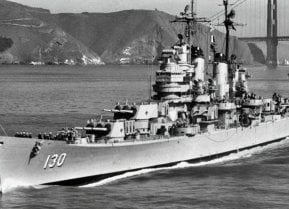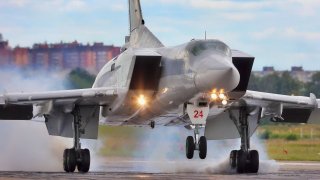Russia's Tupolev Tu-22M Bomber Oozes with Danger
Given the ever-deteriorating status of Russo-U.S. relations, the threat that Tu-22M Backfire bombers could pose to the assets of America and her allies must still be taken seriously.
Meet the Tu-22M: The first definition of the word “backfire” you will find online is, “(of an internal-combustion engine) to have a loud, premature explosion in the intake manifold.” In this age of electronic fuel injection vehicles, you just don’t see or hear that very often, but back in the days of carburetor-dependent motor vehicles – especially the 1974 Cadillac Sedan DeVille – it was a fairly common occurrence.
Nay, nowadays, “backfire” is used more often in the context of the second definition: “To bring a result opposite to that which was planned or expected: The plot backfired.”
So then, with Russian-designed warplanes back in the spotlight thanks to Vladimir Putin’s “special military operation” in Ukraine, now is the right time to ask: Which of the above definitions is more applicable to Russia’s Tupolev Tu-22M “Backfire” bomber?
Tu-22M: Birth of the Backfire Bomber
“Backfire,” of course, is not the Russkies’ nickname for the warbird, but rather the NATO reporting name for the Tupolev Tu-22M (Туполев Ту-22М). The plane was developed in the 1960s by the Tupolev Design Bureau, now officially known as the Joint Stock Company Tupolev. The Tu-22M made its maiden flight on Aug. 30, 1969, and it remains in service to this day, even though production ceased in 1993 after 497 airframes were built.
Dario Leone of The Aviation Geek Club informed us that as of 2014, over 100 Tu-22Ms were still in use – although in that same 2017 article, Dario lets us know the number has dropped by at least one. An individual Backfire overshot the runway while taking off at Shaikavka Airbase during the Zapad 2017 exercise. The plane was damaged beyond repair, but luckily for the 4-person crew, they were all uninjured.
The Tu-22M Backfire is a supersonic, variable-sweep wing, long-range strategic and maritime strike bomber.
As the ever-handy Federation of American Scientists website further elaborates:
“Its low-level penetration features make it a much more survivable system than its predecessors. Carrying either bombs or AS-4/KITCHEN air-to-surface missiles, it is a versatile strike aircraft, believed to be intended for theater attack in Europe and Asia but also potentially capable of intercontinental missions against the United States. The BACKFIRE can be equipped with probes to permit inflight refueling, which would further increase its range and flexibility.”
The most recent variant of the plane, the 1981-vintage Tu-22M3 Backfire C, boasts a maximum airspeed of 2,300 km per hour and an operational range of 7,000 km, powered by two NK-25 turbojet engines.
Its fuselage length is 42.46 meters, its wingspan at full extension is 34.28 meters, and height at the tail is 11.05 meters. Max takeoff weight is 126,400 kg, and it can tote a full bomb load of 24,000 kg.
Tu-22M Backfires In Battle
The Backfire’s first combat took place during the Soviet occupation of Afghanistan in the 1980s, especially during the final year. From there, as noted by the November 2015 issue of Air Force Magazine, “Russian pilots flew some 100 operational sorties against rebels in Chechnya in the mid-1990s and against Georgian forces in the 2008 South Ossetian War.
It was in the latter conflict that the first Backfire was lost in combat, shot down by a Georgian missile.” Coincidentally, during the same month and year that Air Force Mag article was published, Backfires participated alongside Tu-95 Bears and Tu-160 Blackjacks to launch cruise missile strikes against Islamic State targets in Syria.
It should also be noted the Tu-22M has taken losses in the Ukraine war - some in truly epic fashion.
Still a Real Threat to U.S. Interests
Given the ever-deteriorating status of Russo-U.S. relations, the threat that Tu-22M Backfire bombers could pose to the assets of America and her allies must still be taken seriously.
In a January 2019 article for the U.S. Naval Institute’s Proceedings newsletter bluntly titled ,“The Renewed Backfire Bomber Threat to the U.S. Navy,” Dr. Mark B. Schneider warns us:
“The U.S. Navy probably will face an antiship threat from the Backfire for another 20 years. The antisurface strike missiles we currently know about will not be the end of Russian development in this warfare area. Before the Backfire is retired and replaced by the Pak DA heavy stealth bomber, even more advanced missiles, including those with greater stealth and hypersonic speeds, will be fielded…The Navy must soon develop the technology and warfighting doctrine to deal with this increasingly lethal long-range threat.”
Expert Biography
Christian D. Orr is a former Air Force Security Forces officer, Federal law enforcement officer, and private military contractor (with assignments worked in Iraq, the United Arab Emirates, Kosovo, Japan, Germany, and the Pentagon). Chris holds a B.A. in International Relations from the University of Southern California (USC) and an M.A. in Intelligence Studies (concentration in Terrorism Studies) from American Military University (AMU). He has also been published in The Daily Torch and The Journal of Intelligence and Cyber Security. Last but not least, he is a Companion of the Order of the Naval Order of the United States (NOUS).
All images are Shutterstock.


